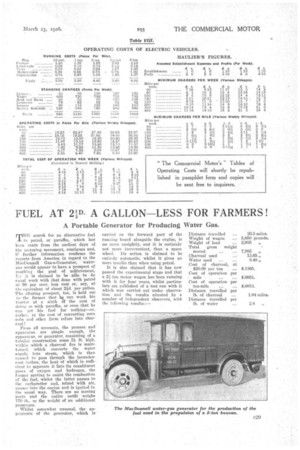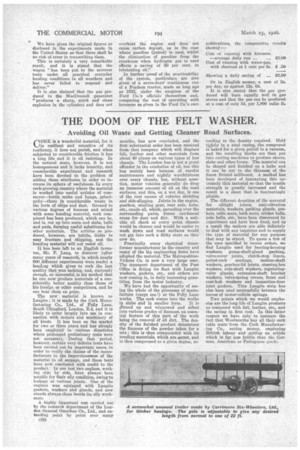FUEL AT 21D. A GALLON-LESS FOR FARMERS!
Page 17

Page 18

If you've noticed an error in this article please click here to report it so we can fix it.
A Portable Generator for Producing Water Gas.
Tim search for an alternative fuel to petrol, or paraffin, which has been made from the earliest days of the motoring movement, continues and, if further information confirms the reports from America in regard to the AlacDonnell Gas-o-Generator, watergas would' appear to have a prospect of reaching the goal of achievement, fce it is claimed to be able to do equal work -with that done with petrol nt 90 per cent. less cost or, say, at the equivalent of about 2id. per gallon. The alluring prospect, too, is held out to the farmer that he can work his tractor at a sixth of the cost of tioing to with paraffin, or even that he can get IN fuel for nothing-or, rather, at the cost of converting corn cobs and other farm refuse into charcoal!
Front all accounts, the process and apparatus are simple enough, the apparatus, or generator, consisting of a tubular construction some 31 ft. high, -within which a charcoal fire is maintained, which converts the water simply into steam, -which is then caused to pass through the incandescent carbon, the heat of which: is sufficient to separate it into its constituent gases of oxygen and hydrogen, the former serving to assist the combustion of the fuel, whilst the latter passes to the carburetter and, mixed -with air, passes into the engine and is ignited in the usual way. There are no moving parts and the entire outfit weighs 170 lb., or the weight of an additional
passenger. •
Whilst somewhat unusual, the appearance of the generator, which is •
carried on the forward part of the running board alongside the engine, is no more unsightly, and it is certainly not more inconvenient, than a spare wheel. Its action is claimed to 'be entirely, automatic, whilst it gives no more trouble than when using petrol.
It is also claimed that it has now passed the experimental stage and that a 211-ton motor wagon has been running with it for four years, whilst particulars are published of a test run with it which was carried out under observation and the results attested by a number of independent observers, with the following results Distance travelled 26.5 miles.
Weight of wagon 5,050 pounds.
Weight of load ... 2,935 Total gross weight • moved ... ... 7,985 „ Charcoal used .... 13.65,, Water used ...9.49 „ ...
Cost of charcoal, at $20.00 per ton ... $.1365. Cost of operation per • mile ... ... $.0051. Cost of operation per ton-mile ... Distance travelled per ... . lb. of charcoal 1.94 miles. Distance travelled per $.0013.
lb. of water ... 2.8
a. We have given the original figures as disclosed in the experiments made in the United States so that there shall be no risk of error in transcribing them. This is certainly a very remarkable result, and it is stated that the wagon "has been put to the severest tests under all practical everyday hauling conditions in all weathers and has never failed to respond and deliver."
It is also claimed that the gas produced in the MacDonnell generator produces a sharp, quick and clean explosion in the cylinders and does not overheat the engine and does not cause carbon deposit, as is the ease where gasoline (petrol) is used, whilst the elimination of gasoline from the crankcase when hydrogen gas is used effects a saving of 50 per cent. in lubricating oil."
In further proof of the practicability of the system, particulars are also given of a seven-days' continuous run of a Fordson tractor, made as long ago as 1922, under the auspices of the Ford Co.'s officials themselves and, comparing the cost of operating with kerosene as given in the Ford Co.'s own publications, the comparative resulta showeti :— Cost of running with kerosene —average daily run 53.011 Cost of running with water-gas, with charcoal at 1 cent per lb. S .50 Showing a daily saving of ... 52.51) Or in English money, a cost of 2s. per day, as against 12s. lid.
It is also stated that the gas produced will burn equally well in gas stoves and that the gas can be produced at a cost of only 3d. per 1,000 cubic ft.
































